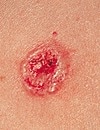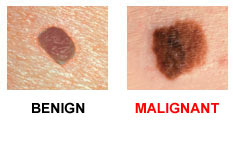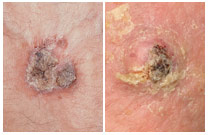|
Despite a wealth of knowledge about prevention, skin cancer cases are increasing, especially in those 15-29 years old. In this post I offer some basic information about skin cancer. Disclaimer: I am not a medical professional and cannot diagnose skin cancer. I do, however, pay attention to lesions that show characteristics of skin cancer and advise my clients to have them checked by a doctor or help them monitor the lesions for changes. All of the following information was gleaned from various sources including The Skin Cancer Foundation, The National Cancer Institute, American Academy of Dermatology, Skin, Inc, and Mary Kay, Inc. What is skin cancer? The National Cancer Institute defines skin cancer as a disease in which cancer cells are found in the outer layers (epidermis) of the skin. The epidermis is comprised mainly of flat, scaly cells called squamous cells; round cells called basal cells; and melanocytes which are the cells that produce melanin. The 3 main types of skin cancer are named for the cells they affect: Squamous Cell Carcinoma, Basal Cell Carcinoma, and Melanoma. Basal Cell Carcinoma • most common form of skin cancer in most ethnic groups • more than 2 million cases diagnosed annually • slow growing and seldom spreads to other parts of the body • typically found on areas exposed to the sun such as head, face, arms & hands • primary risk factor is amount of UV exposure • watch for translucent lesions with irregular, and possible raised, borders and tiny blood vessels through them Squamous Cell Carcinoma • 2nd most common skin cancer in most ethnic groups • 700,000 new cases annually • rarely spread to other body parts, but more commonly so than basal cell carcinoma • found mainly on areas exposed to the sun but can form in mouth lips, and genitals • UV exposure is the primary risk factor for most ethnic groups, but not for people of African descent. In that population the main risk factors are skin conditions that result in scarring or chronic inflammation such as leprosy, burn scars, radiation therapy, and physical trauma to the skin. • characterized by irregular, crusted, red papules (bumps) that don't go away; they often look like warts. Melanoma, aka Cutaneous Melanoma or Malignant Melanoma • least common but most dangerous form of skin cancer across all ethnic groups • more than 87,000 cases of melanoma are expected to be diagnosed in 2017 • CAN spread to other organs through the blood or lymph system • Melanoma lesions can appear anywhere, even under finger or toenails and soles of feet. • Lesions can start as a flat or raised pigmented area. • The overall 5-year survival rate for patients whose melanoma is detected early, before the tumor has spread to regional lymph nodes or other organs, is about 98 percent in the US. The survival rate falls to 62 percent when the disease reaches the lymph nodes, and 18 percent when the disease metastasizes to distant organs. • Know the ABCDE's and have a doctor examine any spot with these characteristics: Asymmetry; Border (irregular or poorly defined); Color (can be varied shades of brown, black, red, blue or white- watch for change of color); Diameter (larger than 6 mm); and Evolving (spot that changes in size, shape, or color). Also have checked any mole that feels hard, lumpy or swollen, is tender to the touch, bleeds, or oozes. • Daily use of sunscreen cuts your risk in HALF. Check your whole body annually. You can print out a mole map and keep track of your spots. If any lesion/spot looks suspicious, see a doctor for diagnosis. You'll find much more in depth information on the websites linked below. Skincancer.org American Academy of Dermatology BODY MOLE MAP These are just a few images of skin cancer lesions. The appearance of lesions varies widely. Consult a doctor about any lesions on your skin that concern you.
6 Comments
6/26/2019 12:13:35 pm
Thank you for explaining that it is important to watch for change in color on spots and that melanoma can spread to other organs. Personally, I've had some family who has had skin cancer so I'll have to look more into it. I'll have to look into MOHS surgery and other treatments for it as well.
Reply
9/24/2019 01:20:45 pm
Thank you for your information on skin cancer. I found it interesting when you said that squamous cell carcinoma is the 2nd most common type of skin cancer. My aunt was recently diagnosed with this type.
Reply
12/6/2019 03:41:16 pm
I didn't know that more than 2 million cases of skin cancer are diagnosed yearly. My sister is worried that she might have skin cancer because she has a mole on her back that is starting to change in appearance. I think that since it is such a prevalent issue it would be smart for her to look into having it checked and what her treatment options would be if she has it so she can be better prepared.
Reply
6/20/2023 12:54:59 am
Awesome! Thank you for providing this important information. I heartily recommend visiting this website in order to learn more about a foot solution.
Reply
7/23/2024 04:01:34 am
Thank you for the comprehensive guide on skin cancer! Your article provides a clear and detailed overview of the types of skin cancer, risk factors, and the importance of early detection. I appreciate the practical tips on how to perform self-exams and the emphasis on regular check-ups with a dermatologist. This post is a valuable resource for raising awareness and educating readers about skin cancer prevention and care. Keep up the excellent work in promoting skin health and providing such essential information!
Reply
Leave a Reply. |
Cindy ShawI am a licensed esthetician and own Renewal Skin & Body Center in Iowa City, IA. I love giving facials and other services that enhance one's appearance. Even more important is to educate people about skin-related services and products. Archives
April 2020
Categories |




 RSS Feed
RSS Feed
